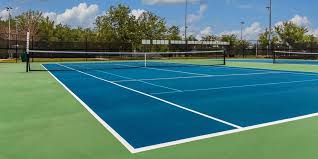Designing a basketball court requires careful attention to detail, from the overall basketball court layout to the specific elements that contribute to functionality, safety, and aesthetics. Whether you are planning to build a new court for a school, community center, or private property, understanding the fundamentals of court layout and design ensures that the final result meets official standards and player expectations. This article explores the essential components of basketball court layout and design to guide you through the process.
Understanding Basketball Court Layout
The basketball court layout involves the precise positioning of all the key markings and zones on the playing surface. basketball court materials This layout must conform to official regulations to guarantee fair play and safety.
Official Dimensions
- Court Size: The standard basketball court size for professional and collegiate play is 94 feet long by 50 feet wide (approximately 28.65 meters by 15.24 meters). High school courts are slightly smaller, measuring 84 feet by 50 feet (25.6 meters by 15.24 meters).
- Key (Paint) Area: This rectangular area beneath the basket is 16 feet wide in the NBA and college courts and 12 feet wide in high school courts. It extends 19 feet from the baseline towards the free-throw line.
- Three-Point Line: The distance varies by level — NBA courts have a 23.75-foot arc (22 feet in the corners), while international courts have a 22.15-foot arc, and high schools typically have a 19.75-foot arc.
- Free-Throw Line: Positioned 15 feet from the backboard, this line defines where players shoot free throws.
Other Important Markings
- Center Circle: A 12-foot diameter circle at midcourt used for jump balls.
- Restricted Area Arc: A semi-circular area near the basket where defenders cannot draw charging fouls.
- Sidelines and Baselines: Define the court boundaries.
Essential Elements of Basketball Court Design
Beyond the layout, basketball court design encompasses the choice of materials, court orientation, lighting, seating, and safety features.
Surface Material and Flooring
The playing surface must provide good traction, shock absorption, and durability. Common materials include hardwood for indoor courts and acrylic-coated asphalt or modular tiles for outdoor courts. The surface choice affects player performance and injury prevention.
Court Orientation and Lighting
Proper orientation minimizes glare from the sun, especially on outdoor courts. Ideally, courts are aligned north-south to reduce direct sunlight in players’ eyes during games. Good lighting design is vital for evening play, ensuring uniform illumination without shadows or glare.
Safety Features
Space around the court is essential for player safety. Typically, at least 3 to 6 feet of clearance is recommended beyond sidelines and baselines to prevent collisions with walls or fences. Padding on posts and barriers further enhances safety.
Seating and Amenities
For public or professional courts, seating arrangements, benches, water stations, and shade structures improve player and spectator comfort. These design elements should blend functionality with aesthetics.
Steps to Create an Effective Basketball Court Layout and Design
- Site Analysis: Assess the location, including space availability, drainage, sunlight, and accessibility.
- Dimension Planning: Mark out the court according to official standards, allowing additional clearance for safety.
- Material Selection: Choose appropriate flooring and materials based on indoor/outdoor use and budget.
- Infrastructure Setup: Plan for lighting, fencing, seating, and net systems.
- Professional Installation: Work with experienced contractors to ensure precise layout and quality construction.
- Maintenance Planning: Incorporate easy-to-maintain materials and schedule regular upkeep for longevity.
Why Proper Layout and Design Matter
A well-designed basketball court provides players with a safe, consistent, and enjoyable environment. Accurate layout ensures fairness and compliance with rules, while thoughtful design elements enhance comfort and durability. Poorly designed courts can lead to uneven play surfaces, safety hazards, and increased maintenance costs.
Conclusion
Achieving the perfect combined with expert basketball court design is essential to delivering a high-quality sports facility. basketball court layout By following official dimension guidelines and considering key design factors such as surface materials, orientation, lighting, and safety, you create a court that meets both player needs and regulatory standards.Whether constructing a new court or upgrading an existing one, investing in proper layout and design will ensure your basketball facility provides years of reliable use, enjoyment, and competitive play.

